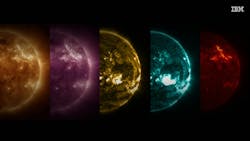IBM and NASA unveil AI model to forecast solar storms and protect technology
Summary points:
- IBM and NASA introduced Surya, an open-source AI model trained on nine years of data from NASA’s Solar Dynamics Observatory.
- Surya improves solar flare prediction accuracy by 16 percent and can visually forecast flare locations up to two hours in advance.
- The model helps protect GPS, telecommunications, power grids, and satellites from the effects of solar storms.
YORKTOWN HEIGHTS, N.Y. - IBM in Yorktown Heights, N.Y., and the National Aeronautics and Space Administration (NASA) have introduced an open-source foundation model called Surya, designed to analyze high-resolution solar observation data and predict how solar activity affects Earth and space-based technology.
Surya, named for the Sanskrit word for the Sun, applies artificial intelligence to solar image interpretation and space weather forecasting. The model aims to help protect GPS navigation, power grids, and telecommunications from solar flares and coronal mass ejections.
Solar storms can knock out satellites, disrupt airline navigation, cause power outages, and endanger astronauts. A Lloyd’s systemic risk study estimated global economic losses from a severe solar storm could reach $2.4 trillion over five years, with $17 billion in expected losses from one major event.
Space weather
"Think of this as a weather forecast for space," said Juan Bernabe-Moreno, director of IBM Research Europe, UK and Ireland. "Surya gives us unprecedented capability to anticipate what’s coming and is not just a technological achievement, but a critical step toward protecting our technological civilization from the star that sustains us."
Trained on nine years of high-resolution data from NASA’s Solar Dynamics Observatory, Surya overcomes limitations of traditional models by processing extremely large solar images. In early testing, researchers reported a 16 percent improvement in solar flare classification accuracy and the ability to visually predict where a flare might occur up to two hours in advance.
Kevin Murphy, NASA’s chief science data officer, said embedding the agency’s heliophysics expertise into AI models helps analyze solar behavior with greater speed and precision.
Surya, released on Hugging Face, is part of IBM and NASA’s broader effort to democratize access to AI tools for scientific research. The collaboration also includes the Prithvi family of models for geospatial analysis and climate forecasting.
About the Author

Jamie Whitney
Jamie Whitney joined the staff of Military & Aerospace Electronics and Intelligent Aerospace. He brings seven years of print newspaper experience to the aerospace and defense electronics industry.
Whitney oversees editorial content for the Intelligent Aerospace Website, as well as produce news and features for Military & Aerospace Electronics, attend industry events, produce Webcasts, oversee print production of Military & Aerospace Electronics, and expand the Intelligent Aerospace and Military & Aerospace Electronics franchises with new and innovative content.
